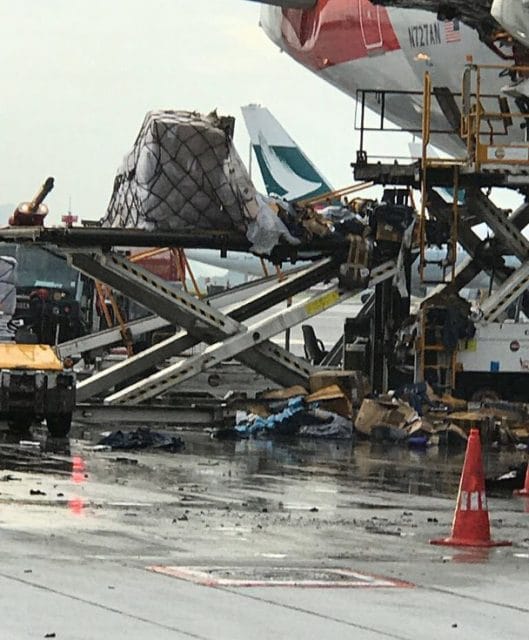Cargo Fire at Hong Kong
On Monday, a cargo loader burst into flames while preparing to load American Airlines flight 192 from Hong Kong to Los Angeles. There’s a lot of embedded video on this post so if you are reading on the mailing list, you might want to click through to the post to view them.
#hongKong #americanairlines Cargo Fire pic.twitter.com/hQUewKZCNF
— Johnny G Jet (@JohnnyGJet) October 9, 2017
Initial reports claimed that the aircraft was on fire although it is clear from watching the videos taken by various people at the airport that the aircraft was not touched — although it surely is a bit too close for comfort! Also, the headlines that the fire was on the runway is clearly a nonsense. Even if it were not obvious from the videos, that’s not where cargo loaders operate! Sometimes the rush to write headlines really does make for the silliest errors.
Cargo fire at Hong Kong Airport. Not yet known damage to this American Airlines Boeing 777 pic.twitter.com/at96EO4ftS
— ChinaAviationReview (@ChinaAvReview) October 9, 2017
The Boeing 777-300ER is the largest in American Airlines’ fleet and flies many of American’s flagship routes. Flight 192 had been scheduled to depart Hong Kong International at 18:10 local time. Although theoretically the aircraft was not harmed, American Airlines decided to cancel the flight and take the 777 out of service. The decision makes sense even if they were sure there was no damage, considering the way the videos and photographs spread like, well, like wildfire. The passengers were rerouted using partner airlines at Hong Kong.
#AmericanAirlines plane scheduled to #LosAngeles engulfed in flames in #HongKong’s international airport on Mon; one person wounded pic.twitter.com/lbFny2OwEP
— People's Daily,China (@PDChina) October 9, 2017
On the following black and white video, the machine operator can be seen jumping from the cargo loader at the beginning and then being ‘helped’ away from the flames from about point 00:50 of the video.
American Airlines confirmed that he is being looked after by medical professionals and that his injuries were not life threatening.
An external piece of loading equipment had a mechanical issue and caught fire while preparing to put cargo in the hold of American Airlines flight 192 from Hong Kong (HKG) to Los Angeles (LAX). As a result, a pallet on the loading equipment containing non-hazardous goods also caught fire.
It’s hard not to feel sorry for the passengers who watched the flames arise next to the aircraft they had been about to board. This caption sums it up, although it looks as though no passenger cargo was affected.
My flight! My luggage! My clothes!
The aftermath looks pretty impressive but all things considered, there’s not a lot of damage.
It’s all a bit of a storm in a teacup, admittedly, but I thought it was interesting to have a front-row seat as a result of modern smart phones and social media!

I just hope no one lost any valuables and that the machine operator is all right!









Before even reading the article, one thing struck me as funny:
Sylvia, you commented that regarding the fire being on the runway: “that is not where cargo loaders operate!” Strictly speaking, of course, you are correct. But when I was flying cargo, at Cologne-Bonn (EDDK) the short runway (32L) would be closed at night and all so-called “feeder” aircraft would be parked there. And of course, loaded.
This was not incidental but every night during the week.
Just to be pedantic !
This incident seems to have been limited in its scope. It seems that the aircraft was not – or not severely – damaged and, of course, it did not happen during the flight.
Carriage of dangerous goods in the hold of passenger-carrying flights is subject to strict rules and restrictions. If I understand it properly, the object matter that caught fire was not in the “dangerous goods” category. And so may have been stacked tight together with other objects. And no NOTOC to give the crew some clue about the nature of what was in the hold, and where.
A fire in the underfloor cargo hold may not be easy to control as fire extinguishing equipment has to compromise between extinguishing a fire and keeping the passengers alive long enough for a diversion and an emergency landing. If the cabin fills with smoke (from an underfloor fire), using the passenger oxygen masks can actually make the situation worse. They can leak and the oxygen that is released can energise the flames.
I think that the crew and passengers of this flight were very lucky.
Looks like a burst hydraulic hose sprayed on an exhaust manifold. Regardless, I’m surprised no one had the presence of mind to even attempt to push the loader away from the aircraft with of the several tugs in the immediate area.
Ernest,
You are quite right about the lack of quick thinking and response. There are a few factors here: First of all, if something like this happens the first reaction is paralysis. Everyone stops to look but does nothing. Next, there is the onset of panic. Large aircraft have tons and tons of flammable liquids and peoples’ instinctive reaction will be to get out of the way. And to crown it all, there are very ingrained rules applicable. These rules are intended to make sure that everyone does their job, meaning their own job. For instance, from a crew vehicle I once watch a few suitcases falling off a trailer heading for the baggage delivery area. There was a certain risk of other ground vehicles hitting them and destroying cases with the luggage.
It would have been easy to pick them up and follow the tractor with it’s train of trailers. But we were not allowed to do so, this sort of thing is strictly forbidden according to the airport bye-laws. Something to do with security.
Aviation personnel, be they flight- or ground crew are very much indoctrinated to act strictly in accordance with the rule book.
Many years ago now, Ryanair had a route Dublin-Manchester-Luton-Dublin and the same again immediately thereafter.
This was before Ryanair became a low-cost carrier, before O’Leary. The passengers could still check in, if I remember well, 10 kg luggage
The aircraft were BAC 1-11.
One day at Luton it so turned out that a suitcase had not been offloaded in Manchester and the operations people were going to sen it from Luton by taxi.
I told them just to put a “rush” tag on and leave it on board. We were going back to Dublin for the next round trip. The suitcase would probably arrive in Manchester before the taxi.
I was told in no uncertain terms not to interfere with operational issues, my job was to fly the aircraft.
So if an incident occurs, staff are trained to step back and waIt for the experts, the fire brigade in this case, to arrive. Unless there is immediate danger to life, ground staff are not allowed to step in. If they do, they may be reprimanded – or worse,
While the aircraft may not have been “officially” involved, it was so close to the fire that I am sure there is at the very least surface damage to clean up (soot, damaged paint, etc). I would not be at all surprised to hear that the aircraft had other damage as well – the flames were quite substantial and very close to the aircraft; given the relative fragility of aircraft skin and how well aluminum conducts heat, there are probably follow on effects within the aircraft.
Better that a fire happen during loading on the ground than at FL410 over the open Pacific…